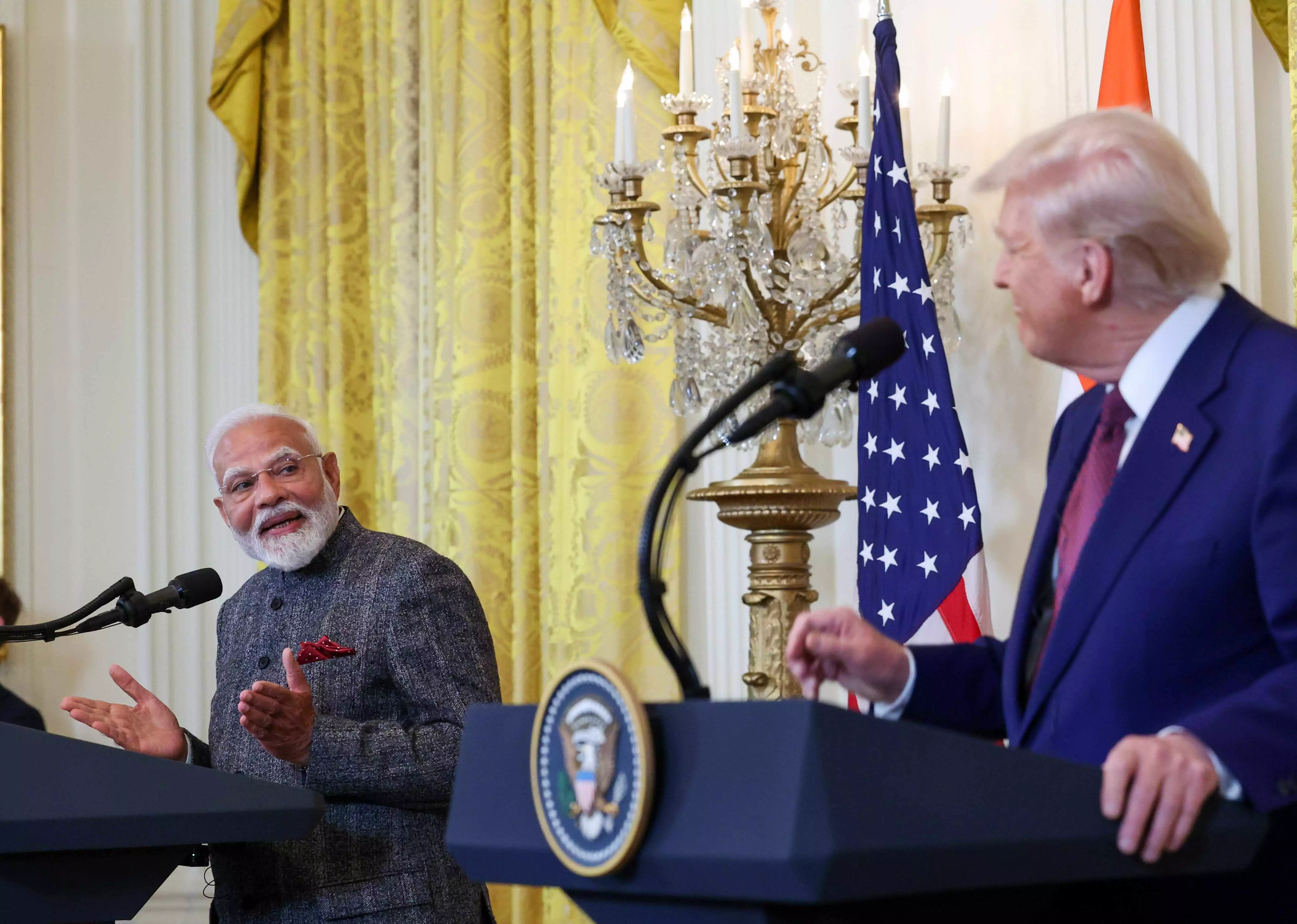Reshaping global power
The recent Trump-Modi meeting reflects economic, defence, and diplomatic recalibrations in Indo-US ties—balancing trade frictions, migration policies, and strategic alliances amid shifting geopolitical currents

Against the backdrop of an increasingly volatile geopolitical landscape, US President Donald Trump and Indian Prime Minister Narendra Modi met at the White House on February 13, 2025. The summit, brimming with diplomatic symbolism and hard-nosed negotiations, underscored a recalibration of Indo-US ties, with trade, defence, and strategic alliances taking centre stage.
Can ‘America First’ and ‘Atmanirbhar Bharat’ coexist?
At the heart of the Trump-Modi dialogue was a push to deepen economic ties, targeting bilateral trade beyond USD 500 billion by 2030. In 2024, Indo-US trade stood at approximately USD 190.1 billion, with India enjoying a USD 50 billion surplus. To address this, Modi proposed expanding India’s imports of American energy, targeting an increase from USD 15 billion to USD 25 billion in the short term.
However, Trump’s persistent demand for tariff reciprocity remains a sticking point. India’s average tariff rate of 12 per cent, compared to the US’s 2.2 per cent, has fuelled disputes. India’s decision to reduce tariffs on American bourbon whiskey from 150 per cent to 100 per cent is a small gesture, but larger concerns over market access, regulatory hurdles, and the fundamental alignment of ‘Make America Great Again’ with ‘Make in India’ policies remain unresolved. Critics argue that India’s move to increase US energy imports raises questions about the long-term feasibility of self-reliance if it leads to overdependence on American oil and gas.
Proponents of US energy imports argue that diversifying India’s energy sources can reduce reliance on volatile Middle Eastern suppliers while ensuring long-term stability in pricing. However, sceptics warn that purchasing expensive American oil and gas could strain India's trade deficit, hinder efforts to develop domestic renewable energy capabilities, and limit India's negotiating power in the global energy market. Additionally, some experts argue that the US energy sector is itself prone to fluctuations, making it an unreliable long-term partner.
Strengthening the defence partnership
Trump reaffirmed Washington’s commitment to bolstering India’s military capabilities, reportedly approving discussions on the sale of F-35 stealth fighter jets. This underscores Washington’s strategic bet on India as a counterweight to China. However, India’s heavy reliance on Russian military hardware complicates the transition to Western defence systems, raising concerns about operational integration and logistical feasibility. The steep costs associated with American defence equipment also pose a challenge, with critics questioning whether such purchases are economically sustainable for India in the long run.
Trump’s Putin gambit
Trump’s renewed outreach to Russian President Vladimir Putin, aimed at ending the war in Ukraine, introduces a diplomatic variable for India. New Delhi has adeptly balanced ties with Washington and Moscow, leveraging discounted Russian oil while strengthening US security ties. A potential US-Russia thaw could alter this dynamic, forcing India to reassess its strategic calculus. Some analysts believe this shift could either reduce India’s diplomatic leverage or open avenues for greater trilateral cooperation. Others argue that India risks losing its unique position as a bridge between rival power blocs, potentially diminishing its influence on the global stage.
The migration dilemma
Immigration policy was central to discussions, with Modi assuring Trump of cooperation in repatriating undocumented Indians while emphasising the vital role of skilled migrants. Over 300,000 Indian students contribute over USD 8 billion annually to the US economy, making a balanced approach crucial for Indo-US economic ties.
However, Trump's stringent policies—visa rejections, work permit delays, and uncertainty around H-1B extensions—have fuelled anxiety among Indian professionals. Critics, justifiably, condemn the harsh deportation methods, urging Modi to secure better treatment and continued opportunities for Indian workers and students despite Trump’s America-first stance.
Strategic risks and economic uncertainties
While diplomatic engagements signal optimism, concerns persist over India’s growing strategic dependence on the US. Critics caution that an overt tilt towards Washington risks diluting India’s traditional non-alignment, potentially compromising its strategic autonomy. Scepticism also surrounds the economic prudence of Modi’s approach, given Trump’s transactional nature and protectionist policies.
High tariffs on Indian exports, especially textiles and pharmaceuticals, pose long-term risks, with Trump’s erratic trade policies making negotiated concessions precarious. Moreover, the wisdom of committing to expensive US energy imports is under scrutiny. As India advances in renewables, aligning with costly American oil and gas could strain fiscal stability and contradict sustainability goals, raising questions about the long-term economic rationale of such commitments.
Will the ‘MEGA’ partnership deliver?
The Trump-Modi summit marks a significant moment in Indo-US relations, but its success will depend on more than grand declarations. Economic friction, shifting US-Russia dynamics, and migration challenges all pose critical tests for this evolving partnership. The question remains: Can this ‘MEGA’ (Make America Great Again + Make India Great Again) partnership evolve into a long-term strategic framework, or will competing national interests dilute its potential?
As the world watches, India and the US must navigate this complex relationship with a mix of pragmatism, caution, and geopolitical finesse. While both leaders project confidence in their partnership, the underlying tensions and unresolved challenges indicate that achieving true synergy will require much more than just diplomatic optics.
The writer is Faculty member, Centre for Excellence in Public Management, West Bengal. Views expressed are personal



